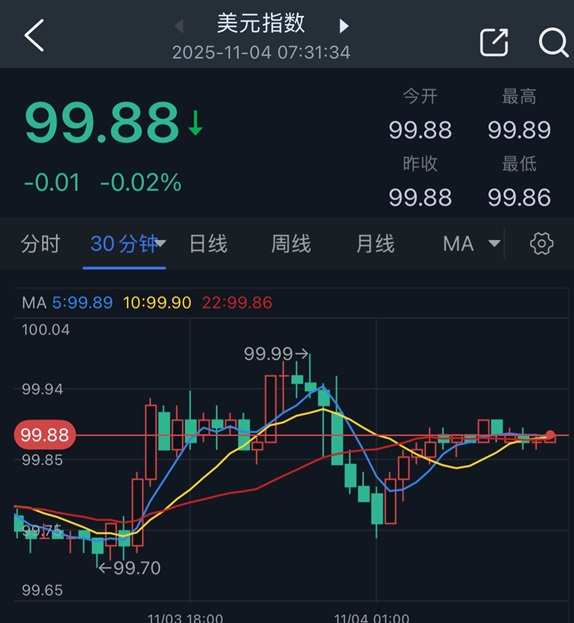[Gold Market Review] What Happened!? Gold Price Surges and Dips by $68; Major News from China Once Triggered a Plunge in Gold Prices

#Gold Market Review# According to a report by 24K99 on Monday (November 3), the gold market experienced extremely volatile fluctuations, with an intraday price swing of $68. However, the closing price remained largely unchanged. Investors are awaiting the release of the US ADP private employment data later this week to assess the likelihood of another interest rate cut by the Federal Reserve this year.
In the early trading session in Asia on Monday, spot gold prices plunged to $3,962.20 per ounce amid significant news from China.
However, the decline in gold prices was not sustained. Influenced by safe-haven capital inflows, gold prices continued to rebound during the Asian session. Entering the European trading session, gold prices rebounded again after a brief decline.
In the early New York trading session on Monday, affected by US PMI data, the US dollar plummeted in the short term, and gold prices surged to $4,030.57 per ounce, reaching the intraday high.

(Spot gold 30-minute chart Source: 24K99)
Gold prices subsequently retreated from the aforementioned high and finally closed at $4,001.38 per ounce, with a slight decline of 0.03% for the day.
Edward Meir, an analyst at Marex, said: ‘Gold prices are forming a trading range, likely between the upper $3,000s and the mid-$4,000s. This consolidation phase is expected following a major price movement.’
Changes in China’s tax policy triggered a sharp drop in gold prices
In the early trading session in Asia on Monday, spot gold prices plunged to $3,962.20 per ounce, with a $40 drop during the session. China abolished its long-standing tax rebate policy for certain retailers, a change that may dampen demand in one of the largest precious metals markets.
According to the latest tax policy announcement on gold by China’s Ministry of Finance, starting from November 1, retailers will no longer enjoy value-added tax (VAT) deductions when selling gold purchased from the Shanghai Gold Exchange, whether sold directly or after processing. This new regulation covers high-purity gold bars, ingots, and investment products such as gold coins approved by the People’s Bank of China, as well as non-investment uses including jewelry and industrial materials.
Adrian Ash, Research Director at BullionVault, stated: “Although China’s gold demand has played a minimal role in this year’s record bull market, changes in tax policy in the world’s largest gold-consuming nation will weigh on global market sentiment. For traders and investors hoping for a larger correction following last month’s surge, this news might bring some relief.”
Under this new policy (which will remain in effect until the end of 2027), tax incentives will only apply to member enterprises of the Shanghai Gold Exchange and the ShanghaiFutures Exchange,provided they plan to sell gold as an investment product. These member enterprises include major banks, refineries, and processors that are directly involved in gold trading.
For companies no longer eligible for this benefit, they can only deduct 6% of input value-added tax (VAT) when selling gold to downstream entities, compared to the previous 13%.
This regulation will apply to all jewelry production and industrial uses, as well as companies producing investment products such as gold bars and coins but not participating in the exchanges. The specific impact will still depend on the implementation details.
US PMI Data Sparks Surge in Gold Prices to Intraday Highs
Affected by declining output and weak demand, US manufacturing activity contracted for the eighth consecutive month in October.
According to data released on Monday, the Institute for Supply Management’s (ISM) Manufacturing Purchasing Managers’ Index (PMI) fell by 0.4 points to 48.7. A reading below 50 indicates a contraction in the sector. Economists had previously forecast the US ISM Manufacturing PMI for October to be 49.1.
The report shows that the ISM production index fell by 2.8 points to 48.2, marking the second time in the past three months that it has dropped below the 50-point threshold that separates expansion from contraction. Weak production continues to weigh on manufacturing employment. The ISM employment index contracted for the ninth consecutive month.
Following the release of the data, the US Dollar Index quickly declined from near the 100 level, hitting a low of 99.74; spot gold surged to an intraday high of $4030.57 per ounce.

(30-minute chart of the US Dollar Index Source: 24K99)
Susan Spence, Chair of the ISM Manufacturing Survey Committee, stated that manufacturers remain concerned about the widespread lack of clarity in trade policy under the Trump administration.
With the U.S. government shutdown halting the release of official data, economists and policymakers are increasingly relying on data published by private institutions like the ISM to find clues about the economy and labor market.
Focus shifts to US ADP employment data
Gold prices have soared 53% year-to-date but have fallen more than 8% from their historical high on October 20.
Investors are awaiting the upcoming US ADP employment data this week for clues regarding the direction of the Federal Reserve’s policy.
Since the US government shutdown began, the release of many key economic data has been suspended, including data from the Bureau of Labor Statistics.
The Federal Reserve announced its second interest rate cut of the year last week. Traders currently expect a 65.3% probability of a rate cut in December, down from nearly 100% before last week’s Fed meeting.
Gold itself does not generate interest and typically performs well during periods of low interest rates and economic uncertainty.
Ole Hansen, Head of Commodity Strategy at Saxo Bank, said: “The pause in gold’s rally appears to be just a breather rather than a collapse. Seasonal weakness, temporary noise from Chinese policy, and a stronger dollar are all contributing to the short-term pullback, but none of these factors have altered the long-term trend for gold prices.”




